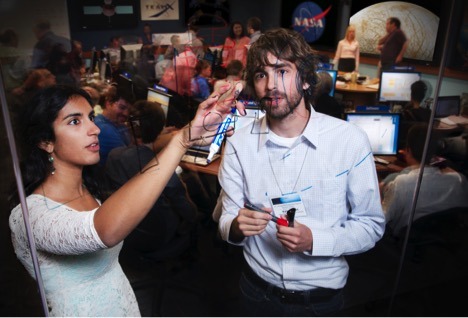Latest Posts by nasalangley - Page 4
See what goes on behind the gates of the NASA Langley Research Center (LaRC)!
Travel Posters of Fantastic Excursions
What would the future look like if people were regularly visiting to other planets and moons? These travel posters give a glimpse into that imaginative future. Take a look and choose your destination:
The Grand Tour

Our Voyager mission took advantage of a once-every-175-year alignment of the outer planets for a grand tour of the solar system. The twin spacecraft revealed details about Jupiter, Saturn, Uranus and Neptune – using each planet’s gravity to send them on to the next destination.
Mars

Our Mars Exploration Program seeks to understand whether Mars was, is, or can be a habitable world. This poster imagines a future day when we have achieved our vision of human exploration of the Red Planet and takes a nostalgic look back at the great imagined milestones of Mars exploration that will someday be celebrated as “historic sites.”
Earth

There’s no place like home. Warm, wet and with an atmosphere that’s just right, Earth is the only place we know of with life – and lots of it. Our Earth science missions monitor our home planet and how it’s changing so it can continue to provide a safe haven as we reach deeper into the cosmos.
Venus

The rare science opportunity of planetary transits has long inspired bold voyages to exotic vantage points – journeys such as James Cook’s trek to the South Pacific to watch Venus and Mercury cross the face of the sun in 1769. Spacecraft now allow us the luxury to study these cosmic crossings at times of our choosing from unique locales across our solar system.
Ceres

Ceres is the closest dwarf planet to the sun. It is the largest object in the main asteroid belt between Mars and Jupiter, with an equatorial diameter of about 965 kilometers. After being studied with telescopes for more than two centuries, Ceres became the first dwarf planet to be explored by a spacecraft, when our Dawn probe arrived in orbit in March 2015. Dawn’s ongoing detailed observations are revealing intriguing insights into the nature of this mysterious world of ice and rock.
Jupiter

The Jovian cloudscape boasts the most spectacular light show in the solar system, with northern and southern lights to dazzle even the most jaded space traveler. Jupiter’s auroras are hundreds of times more powerful than Earth’s, and they form a glowing ring around each pole that’s bigger than our home planet.
Enceladus

The discovery of Enceladus’ icy jets and their role in creating Saturn’s E-ring is one of the top findings of the Cassini mission to Saturn. Further Cassini discoveries revealed strong evidence of a global ocean and the first signs of potential hydrothermal activity beyond Earth – making this tiny Saturnian moon one of the leading locations in the search for possible life beyond Earth.
Titan

Frigid and alien, yet similar to our own planet billions of years ago, Saturn’s largest moon, Titan has a thick atmosphere, organic-rich chemistry and surface shaped by rivers and lakes of liquid ethane and methane. Our Cassini orbiter was designed to peer through Titan’s perpetual haze and unravel the mysteries of this planet-like moon.
Europa

Astonishing geology and the potential to host the conditions for simple life making Jupiter’s moon Europa a fascinating destination for future exploration. Beneath its icy surface, Europa is believed to conceal a global ocean of salty liquid water twice the volume of Earth’s oceans. Tugging and flexing from Jupiter’s gravity generates enough heat to keep the ocean from freezing.
You can download free poster size images of these thumbnails here: http://www.jpl.nasa.gov/visions-of-the-future/
Make sure to follow us on Tumblr for your regular dose of space: http://nasa.tumblr.com
There are amazing opportunities at each center. Learn more at: https://intern.nasa.gov
So you want to work at NASA?
An out of this world career or internship might not be as far out of reach as you think. Check out all the ways you can get involved!
If you’re a student…

Our internships are the perfect place to start! We offer paid internships for spring, summer, and fall semesters to U.S. citizens currently attending an accredited university full time. Learn more at: https://intern.nasa.gov
Seriously considering a job in the Federal civil service? Check out the Pathways Internship Program which allows you to do multiple work tours while you finish school: http://nasajobs.nasa.gov/studentopps/employment/iep.htm
If you’re a recent graduate…

If you’re a U.S. citizen who has graduated from an accredited college or university within the past 2 years (or 6 if you have served in the military), then the our Recent Graduates program is just for you. Accepted applicants are placed in a 1 year career development program with the possibility of an additional year, or even granted term or permanent jobs within the agency. Learn more at: http://nasajobs.nasa.gov/studentopps/employment/rgp.htm.
If you’re a professional…

You can search for our job openings any time at USAJobs.com. Create an account, then use the USAJobs resume builder. Want to make sure your resume maximizes your opportunity for a job at NASA? Check out our Applicant Guide: https://applyonline.nasa.gov/applicant_guide.html.
You can then search for our job openings here: https://nasai.usajobs.gov/.
If you want to be an astronaut…

Astronaut candidate applications are accepted every few years- including right now! Get yours in before the current application closes on February 18, 2016.
Do you have a bachelor’s degree in a STEM field and 3 years of related professional experience? You might be eligible. Find out more and apply online at: https://nasai.usajobs.gov/GetJob/ViewDetails/423817000.
Make sure to follow us on Tumblr for your regular dose of space: http://nasa.tumblr.com

We’re Turning 100! Celebrate With Us